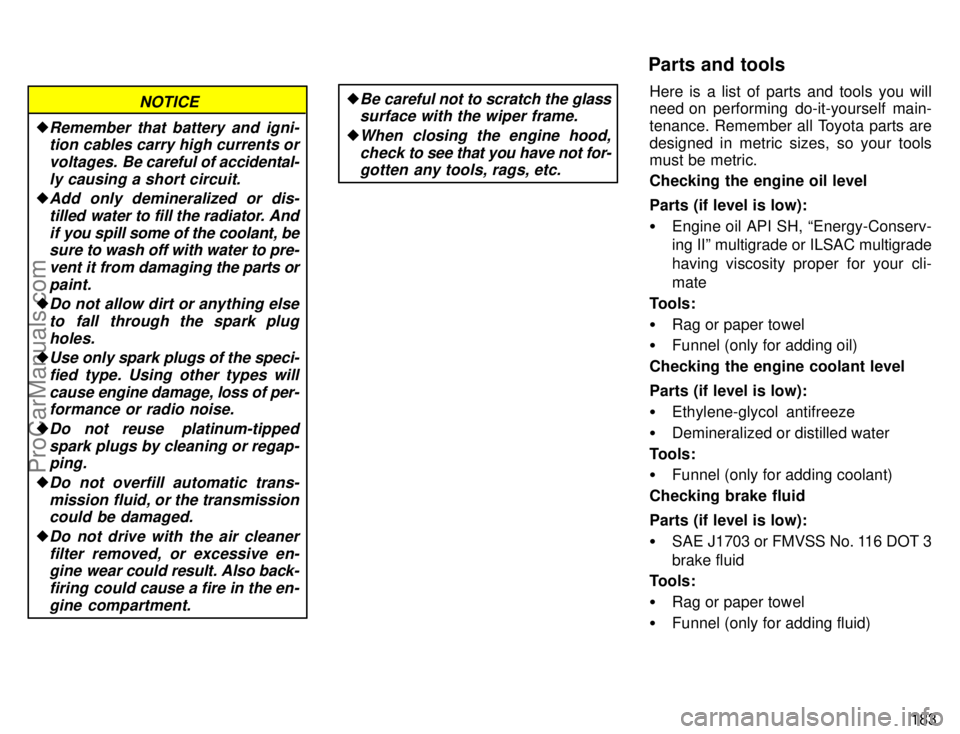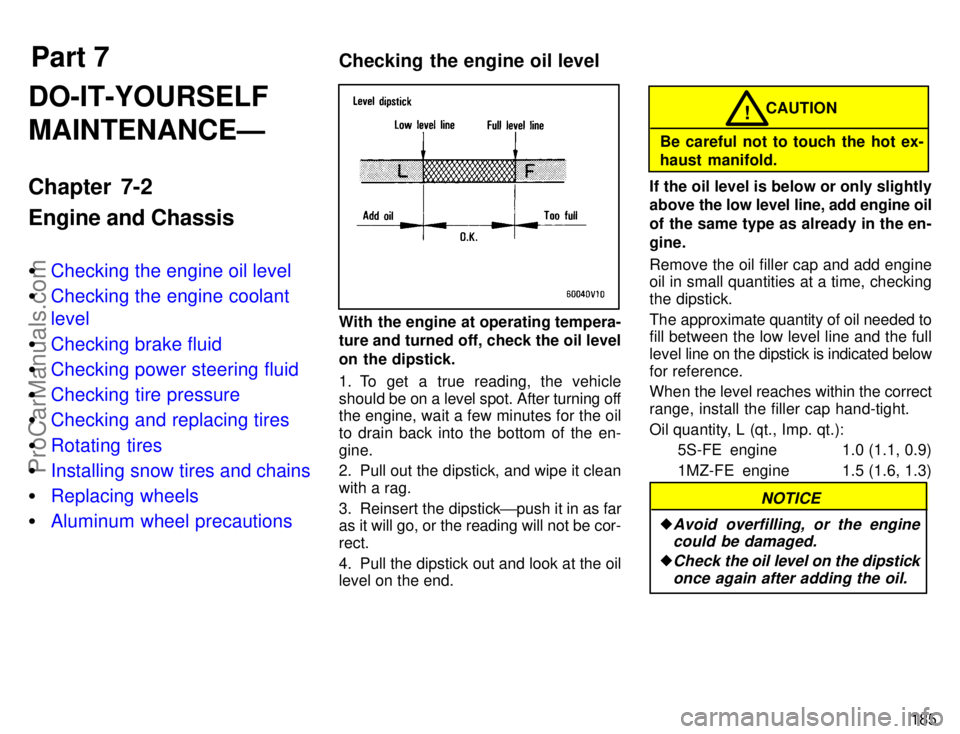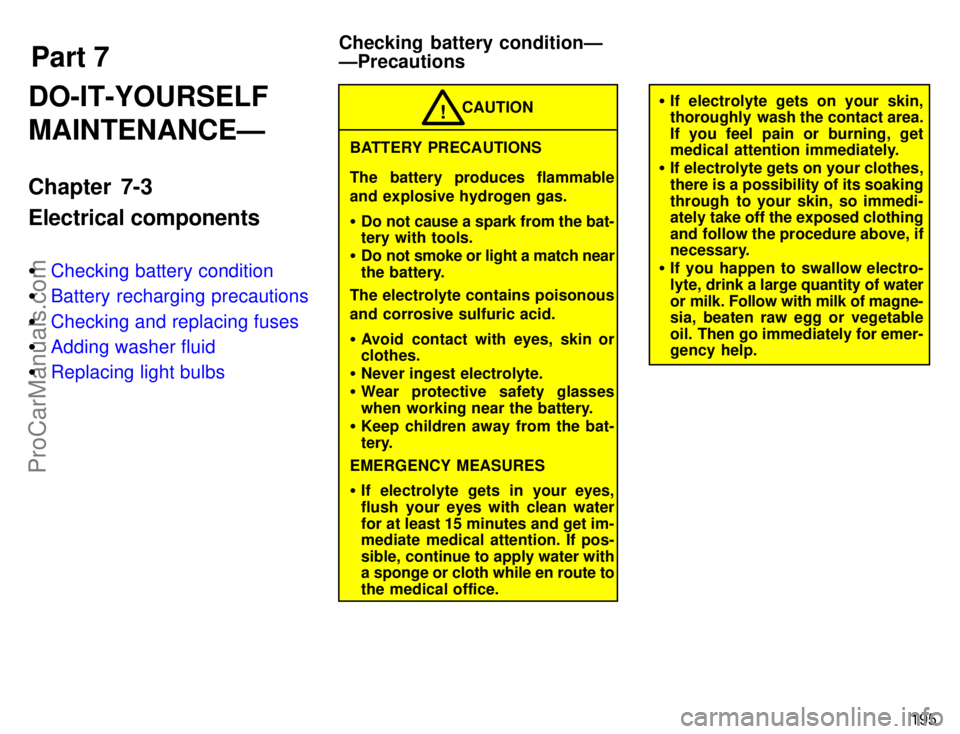Page 180 of 226

174IN THE ENGINE COMPARTMENT
Items listed below should be checked
from time to time, e.g. each time when
refueling.
Washer fluid
Make sure there is sufficient fluid in the
tank. See Chapter 7-3 for additional infor-
mation.
Engine coolant level
Make sure the coolant level is between
the FULLº and LOWº lines on the see-
through reservoir. See Chapter 7-2 for
additional information.
Battery electrolyte level
Make sure the electrolyte level of all bat-
tery cells is between upper and lower level
lines on the case. Add only distilled water
when replenishing. See Chapter 7-3 for
additional information.
Brake fluid level
Make sure the brake fluid level is correct.
See Chapter 7-2 for additional informa-
tion.
Engine oil level
Check the level on the dipstick with the en-
gine turned off and the vehicle parked on
a level spot. See Chapter 7-2 for addition-
al information.Power steering fluid level
Check the level through the reservoir. The
level should be in the HOTº or COLDº
range depending on the fluid temperature.
See Chapter 7-2 for additional informa-
tion.
Exhaust system
If you notice any change in the sound of
the exhaust or smell exhaust fumes, have
the cause located and corrected immedi-
ately. (See engine exhaust cautions in
Part 2.)ProCarManuals.com
Page 189 of 226

183
NOTICE
�Remember that battery and igni-
tion cables carry high currents or
voltages. Be careful of accidental-
ly causing a short circuit.
�Add only demineralized or dis-
tilled water to fill the radiator. And
if you spill some of the coolant, be
sure to wash off with water to pre-
vent it from damaging the parts or
paint.
�Do not allow dirt or anything else
to fall through the spark plug
holes.
�Use only spark plugs of the speci-
fied type. Using other types will
cause engine damage, loss of per-
formance or radio noise.
�Do not reuse platinum-tipped
spark plugs by cleaning or regap-
ping.
�Do not overfill automatic trans-
mission fluid, or the transmission
could be damaged.
�Do not drive with the air cleaner
filter removed, or excessive en-
gine wear could result. Also back-
firing could cause a fire in the en-
gine compartment.
�Be careful not to scratch the glass
surface with the wiper frame.
�When closing the engine hood,
check to see that you have not for-
gotten any tools, rags, etc.
Here is a list of parts and tools you will
need on performing do-it-yourself main-
tenance. Remember all Toyota parts are
designed in metric sizes, so your tools
must be metric.
Checking the engine oil level
Parts (if level is low):
�Engine oil API SH, Energy-Conserv-
ing IIº multigrade or ILSAC multigrade
having viscosity proper for your cli-
mate
Tools:
�Rag or paper towel
�Funnel (only for adding oil)
Checking the engine coolant level
Parts (if level is low):
�Ethylene-glycol antifreeze
�Demineralized or distilled water
Tools:
�Funnel (only for adding coolant)
Checking brake fluid
Parts (if level is low):
�SAE J1703 or FMVSS No. 116 DOT 3
brake fluid
Tools:
�Rag or paper towel
�Funnel (only for adding fluid)
Parts and tools
ProCarManuals.com
Page 191 of 226

Part 7Checking the engine oil level
185
DO-IT-YOURSELF
MAINTENANCEÐ
Chapter 7-2
Engine and Chassis
�Checking the engine oil level
�Checking the engine coolant
level
�Checking brake fluid
�Checking power steering fluid
�Checking tire pressure
�Checking and replacing tires
�Rotating tires
�Installing snow tires and chains
�Replacing wheels
�Aluminum wheel precautions
With the engine at operating tempera-
ture and turned off, check the oil level
on the dipstick.
1. To get a true reading, the vehicle
should be on a level spot. After turning off
the engine, wait a few minutes for the oil
to drain back into the bottom of the en-
gine.
2. Pull out the dipstick, and wipe it clean
with a rag.
3. Reinsert the dipstick'push it in as far
as it will go, or the reading will not be cor-
rect.
4. Pull the dipstick out and look at the oil
level on the end.
CAUTION!
Be careful not to touch the hot ex-
haust manifold.
If the oil level is below or only slightly
above the low level line, add engine oil
of the same type as already in the en-
gine.
Remove the oil filler cap and add engine
oil in small quantities at a time, checking
the dipstick.
The approximate quantity of oil needed to
fill between the low level line and the full
level line on the dipstick is indicated below
for reference.
When the level reaches within the correct
range, install the filler cap hand-tight.
Oil quantity, L (qt., Imp. qt.):
5S-FE engine 1.0 (1.1, 0.9)
1MZ-FE engine 1.5 (1.6, 1.3)
NOTICE
�Avoid overfilling, or the engine
could be damaged.
�Check the oil level on the dipstick
once again after adding the oil.
ProCarManuals.com
Page 201 of 226

Part 7
Checking battery conditionÐ
ÐPrecautions
195
DO-IT-YOURSELF
MAINTENANCEÐ
Chapter 7-3
Electrical components
�Checking battery condition
�Battery recharging precautions
�Checking and replacing fuses
�Adding washer fluid
�Replacing light bulbs
BATTERY PRECAUTIONS
The battery produces flammable
and explosive hydrogen gas.
�Do not cause a spark from the bat-
tery with tools.
�Do not smoke or light a match near
the battery.
The electrolyte contains poisonous
and corrosive sulfuric acid.
�Avoid contact with eyes, skin or
clothes.
�Never ingest electrolyte.
�Wear protective safety glasses
when working near the battery.
�Keep children away from the bat-
tery.
EMERGENCY MEASURES
�If electrolyte gets in your eyes,
flush your eyes with clean water
for at least 15 minutes and get im-
mediate medical attention. If pos-
sible, continue to apply water with
a sponge or cloth while en route to
the medical office.CAUTION
!�If electrolyte gets on your skin,
thoroughly wash the contact area.
If you feel pain or burning, get
medical attention immediately.
�If electrolyte gets on your clothes,
there is a possibility of its soaking
through to your skin, so immedi-
ately take off the exposed clothing
and follow the procedure above, if
necessary.
�If you happen to swallow electro-
lyte, drink a large quantity of water
or milk. Follow with milk of magne-
sia, beaten raw egg or vegetable
oil. Then go immediately for emer-
gency help.
ProCarManuals.com
Page 217 of 226

211 1MZ-FE engine
With air conditioning
Generator belt 115 + 20
Power steering pump belt 115 + 20
Without air conditioning
Generator belt 115 + 20
Power steering pump belt 115 + 20
ENGINE LUBRICATION
Oil capacity (drain and refill), L (qt., Imp.
qt.):
5S-FE engine
With filter 3.6 (3.8, 3.2)
Without filter 3.4 (3.6, 3.0)
1MZ-FE engine
With filter 4.7 (5.0, 4.1)
Without filter 4.5 (4.8, 4.0)
Oil grade:
API SH, Energy-Conserving IIº multi-
grade engine oil or ILSAC multigrade
engine oil is recommended.Recommended oil viscosity (SAE):
COOLING SYSTEM
Total capacity, L (qt., Imp. qt.):
5S-FE engine 6.3 (6.7, 5.5)
1MZ-FE engine 9.3 (9.3, 8.2)Coolant type:
With ethylene-glycol antifreeze
(Do not use alcohol type.)
BATTERY
ÐMaintenance type battery
Specific gravity reading at 20�C (68�F):
1.260 Fully charged
1.160 Half charged
1.060 Discharged
ÐNon-Maintenance battery
Open voltage* at 20�C (68�F):
12.7V Fully charged
12.3V Half charged
11.9V Discharged
*: Voltage that is checked 20 minutes af-
ter the key is removed with all the lights
turned off
Charging rates:
Non-maintenance battery 5 A max.
Maintenance type battery
Quick charge 15 A max.
Slow charge 5 A max.
CLUTCH
Pedal freeplay, mm (in.):
5'15 (0.2'0.6)
Fluid type:
SAE J1703 or FMVSS No. 116 DOT 3
ProCarManuals.com